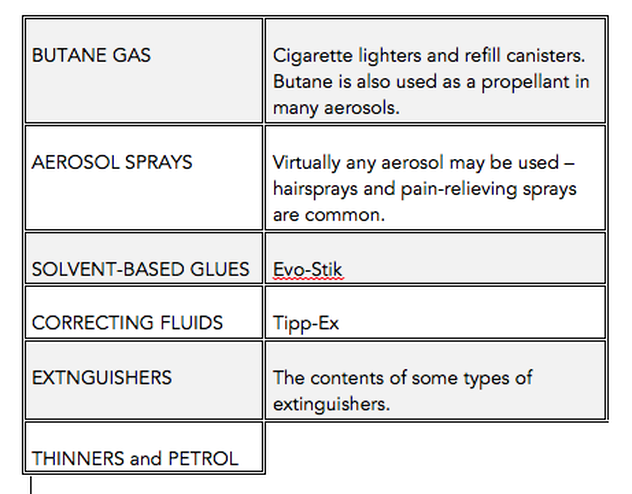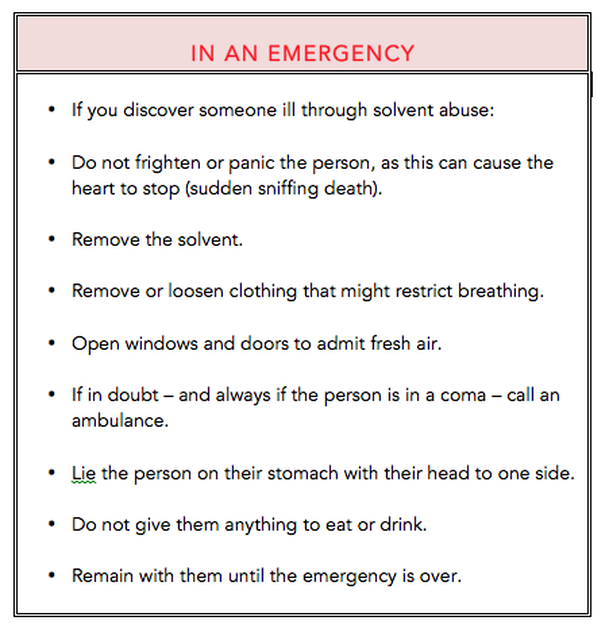SOLVENTS
THE SIGNS - THE DANGERS - WHAT TO DO ...
Solvent sniffing is common and this article should help you understand more about solvent misuse.
There are a huge number of deaths annually from solvent sniffing, and most of those who die are teenagers. Some youngsters who sniff have accidents while they are intoxicated, and others may suffer damage to their health.
Solvent sniffing usually means getting 'high' by breathing in the fumes from butane, aerosols, glues or other products found around most people's homes, or which are easily available in shop
There are a huge number of deaths annually from solvent sniffing, and most of those who die are teenagers. Some youngsters who sniff have accidents while they are intoxicated, and others may suffer damage to their health.
Solvent sniffing usually means getting 'high' by breathing in the fumes from butane, aerosols, glues or other products found around most people's homes, or which are easily available in shop
IN THE AVERAGE HOME THERE ARE OVER 50 SNIFFABLE PRODUCTS
WHO ... WHY ... HOW ... WHERE ... THE EFFECTS ... THE DANGERS
RECOGNISING A SNIFFER IN AN EMERGENCY
RECOGNISING A SNIFFER IN AN EMERGENCY
WHO
About one in ten secondary school children try sniffing and most of these will only experiment, although few may become heavy and frequent solvent misusers.
About one in ten secondary school children try sniffing and most of these will only experiment, although few may become heavy and frequent solvent misusers.
WHY
- For some young people, sniffing is a pleasurable activity - they can have a laugh and for some, they feel it releases them momentarily from their problems and inhibitions.
- Solvents are cheaper, easier to buy or steal, and more accessible than alcohol.
- The youngsters enjoy the excitement of sniffing solvents, perhaps partly because of the element of danger.
- Others enjoy experimenting or the attraction of playing with a new physical sensation.
- Hallucinations when sniffing can be interesting and exciting, dangerous, unpleasant and frightening, but even these can be enjoyable (think of a horror film), and allow youngsters to 'escape' - if only temporarily and only in their imagination.
HOW
- Because there is such a wide range of substances, there are many ways they can be misused.
- Butane gas and aerosols may be sniffed from bags, but are sometimes sprayed directly into the mouth.
- Glue is generally sniffed from bags, often freezer or crisp bags. The vapours are inhaled through the nose and mouth and this is sometimes known as 'huffing'.
- Thinners, such as Tipp-Ex, may be sniffed from a cloth or a coat-sleeve. Others may put their heads inside a plastic bag.
WHERE
- Sniffable products are widely available and they are portable.
- They can sniff while walking around. They can sniff in school or anywhere around the home or streets.
- They may sniff in bed, using the bedcovers as a tent to contain the fumes.
- Some solvent misusers may absorb the product onto a rage (which they carry in their pocket) or onto a piece of their clothing.
THE EFFECTS
The effects of sniffing are similar to being drunk on alcohol, but the effects are obtained more quickly from sniffing because the substances enter the blood-stream from the lungs instead of from the stomach. This can take new users by surprise - they become intoxicated before they realise it. The effects of sniffing wear off quickly also.
The effects of sniffing are similar to being drunk on alcohol, but the effects are obtained more quickly from sniffing because the substances enter the blood-stream from the lungs instead of from the stomach. This can take new users by surprise - they become intoxicated before they realise it. The effects of sniffing wear off quickly also.
THE DANGERS
Some people are more vulnerable than others to the harmful effects of solvents and may suffer lasting damage to the liver, kidneys, lungs, bone marrow or the nervous system.
- Sniffing these substances can be lethal or cause long-term damage.
- Sniffing can have an effect on the heart, so if it is followed by exertion or fright, death may result.
- If butane gas or aerosols are sprayed directly into the mouth, they may cool the tissues causing swelling and perhaps suffocation.
- Most sniffable products are a mixture of chemicals and the manufacturers may change their formulation. This makes it hard to assess the dangers of particular products.
- Some solvents contain poisonous substances, such as lead in some petrol.
- Since many of these products are inflammable, there is a fire risk, especially when youngsters combine sniffing and smoking.
- Using solvents with other drugs, like alcohol, may add to the dangers.
- As a result of 'hallucination', solvent misusers are subject to dangers.
- If solvent misusers use large plastic bags, they may suffocate.
Some people are more vulnerable than others to the harmful effects of solvents and may suffer lasting damage to the liver, kidneys, lungs, bone marrow or the nervous system.
RECOGNISING A SNIFFER
There are no clear-cut signs and symptoms that will identify someone who has been sniffing. Many of the effects are indistinguishable from the normal processing of growing up. However, look out for:
There are no clear-cut signs and symptoms that will identify someone who has been sniffing. Many of the effects are indistinguishable from the normal processing of growing up. However, look out for:
- Quantities of empty butane, aerosol or glue cans - or plastic bags
- Chemical smell on clothes or breath
- Drunken behaviour
- Sudden change in behaviour or lifestyle - wide mood swings
- Loss of appetite
- Secretiveness about leisure-time activities
- Asking for money with explaining what it is for

